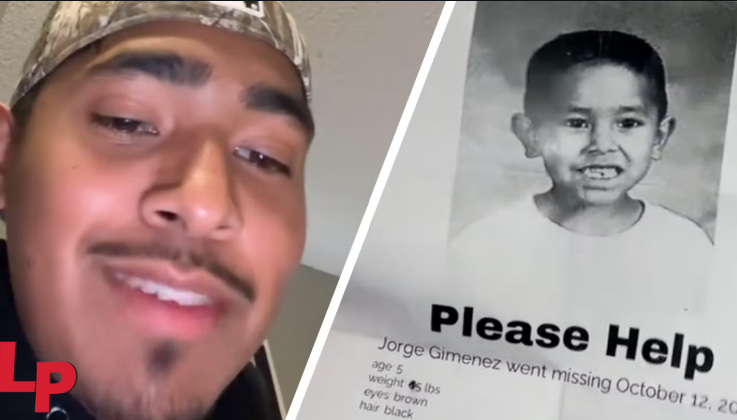
A bizarre case surfaced when a man found a missing child poster with his childhood photo but under a different name, Jorge Gimenez. Read on to uncover the mystery.
The internet loves a good mystery, and the case of Jorge Gimenez is no exception. A TikTok user, Adrian Peru, stumbled upon an old missing child poster featuring his childhood image under the name Jorge Gimenez. What followed was a whirlwind of speculation, conspiracy theories, and shocking revelations. Was it a mistake, a scam, or something more sinister?
Let’s look into this mystery.
Who Is Jorge Gimenez?
Jorge Gimenez was supposedly a child who went missing on October 12, 2005. According to the missing person flyer, he was five years old, weighed 45 lbs, and had brown eyes and black hair. The flyer urged people to contact authorities if they had any information.
However, the person in the photo was not Jorge Gimenez but Adrian Peru. This revelation left him confused and searching for answers.
The Discovery of the Missing Poster
Adrian Peru, a popular TikTok personality, was going through his paperwork when he found the poster. It was mixed in with his birth certificate and personal documents. The moment he saw it, he was in shock.
The text on the flyer read:
“Please help. Jorge Gimenez went missing October 12, 2005. Age: 5, weight: 45lbs, eyes: brown, hair: black. If you have information, please contact [redacted]. Come home soon, Jorge. We all love you and want you home safe.”
Peru was left wondering—how did his picture end up on a missing child flyer? And who was Jorge Gimenez?
Theories Behind the Poster
Social media users quickly jumped to conclusions, and various theories emerged:
- Kidnapping Theory: Many speculated that Adrian Peru was actually kidnapped as a child and given a new identity.
- Clerical Error: Some believed it was an innocent mistake, where authorities mixed up photos.
- Family Secrets: A few suggested that Peru’s family had hidden something from him.
- Human Trafficking Scam: Another theory was that the flyer was part of a trafficking operation.
The Real Story Unfolds
Peru called his mother, demanding an explanation. She confirmed that the child in the flyer was indeed him, but insisted he had never been kidnapped. Instead, she recalled authorities accidentally using the wrong photo in the missing poster.
Peru further revealed that part of his real name contains “Gimen,” which might explain the mix-up.
Despite his mother’s assurance, the incident left many unanswered questions. Was it truly a simple mistake, or was there more to the story?
Potential Scams and Fake Posters
The idea of fake missing child posters isn’t new. Some scams involve placing a random child’s image on a flyer in an attempt to lure unsuspecting people into revealing the child’s location.
The Amber Alert Advocate has identified red flags for fake missing child posters:
- The flyer does not come from the National Center for Missing & Exploited Children (NCMEC) or a credible law enforcement agency.
- Misspellings, syntax errors, or improper grammar.
- Lack of verifiable sources or official contact details.
How to Spot Fake Missing Child Posters
If you ever come across a missing child flyer, here are some ways to verify its authenticity:
- Check Official Sources: Cross-check the information with NCMEC or local authorities.
- Look for Misspellings: Fake posters often have grammatical errors.
- Verify Contact Details: Authentic flyers will have police or nonprofit organization contacts.
- Search Online: A quick internet search can reveal if the flyer is genuine or a hoax.
Conclusion
The case of Jorge Gimenez remains an internet mystery. While Adrian Peru insists that it was a mistake, the story continues to spark debates. Whether it was a simple mix-up or something more sinister, this case highlights the importance of verifying information before jumping to conclusions.
FAQs
1. Was Adrian Peru kidnapped as a child?
No, according to his mother, it was a clerical error where the wrong photo was used in the missing child poster.
2. Who is Jorge Gimenez?
There are no known records of a missing child named Jorge Gimenez from the early 2000s.
3. Are fake missing child posters common?
Yes, fake posters are often used for clickbait scams rather than human trafficking.
4. What should I do if I see a suspicious missing child poster?
Verify the information through official sources like NCMEC or law enforcement before sharing it.
5. Could the missing child poster have been part of a scam?
It’s possible. Some scams involve using random children’s photos to create false narratives for various motives.
The case of Jorge Gimenez serves as a reminder that not everything on the internet is as it seems. Always question, verify, and think critically before accepting a story at face value.





